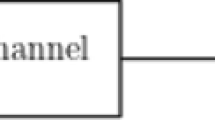Abstract
Relative dimension/length profile (RDLP), inverse relative dimension/length profile (IRDLP) and relative length/dimension profile (RLDP) are equivalent sequences of a linear code and a subcode. The concepts were applied to protect messages from an adversary in the wiretap channel of type II with illegitimate parties. The equivocation to the adversary is described by IRDLP and upper-bounded by the generalized Singleton bound on IRDLP. Recently, RLDP was also extended in wiretap network II for secrecy control of network coding. In this paper, we introduce new relations and bounds about the sequences. They not only reveal new connections among known results but also find applications in trellis complexities of linear codes. The state complexity profile of a linear code and that of a subcode can be bounded from each other, which is particularly useful when a tradeoff among coding rate, error-correcting capability and decoding complexity is considered. Furthermore, a unified framework is proposed to derive bounds on RDLP and IRDLP from an upper bound on RLDP. We introduce three new upper bounds on RLDP and use some of them to tighten the generalized Singleton bounds by applying the framework. The approach is useful to improve equivocation estimation in the wiretap channel of type II with illegitimate parties.
Similar content being viewed by others
References
Encheva S., Kløve T.: Codes satisfying the chain condition. IEEE Trans. Inf. Theory 40(1), 175–180 (1994).
Forney G.D.: Dimension/length profiles and trellis complexity of linear block codes. IEEE Trans. Inf. Theory 40(6), 1741–1752 (1994).
Helleseth T., Kløve T., Mykkelveit J.: The weight distribution of irreducible cyclic codes with block length n 1((q l−1)/N)n. Discret. Math. 18, 179–211 (1977).
Helleseth T., Kløve T., Ytrehus Ø.: Generalized Hamming weights of linear codes. IEEE Trans. Inf. Theory 38(3), 1133–1140 (1992).
Helleseth T., Kløve T., Levenshtein V.I., Ytrehus Ø.: Bounds on the minimum support weights. IEEE Trans. Inf. Theory 41(2), 432–440 (1995).
Huffman W.C., Pless V.: Fundamentals of Error-Correcting Codes. Cambridge University, Cambridge (2003).
Hughes D.R., Piper F.C.: Design Theory. Cambridge University, Cambridge (1998).
Kløve T.: Support weight distribution of linear codes. Discret. Math. 107, 311–316 (1992).
Lafourcade A., Vardy A.: Lower bounds on trellis complexity of block codes. IEEE Trans. Inf. Theory 41(6), 1938–1954 (1995).
Lin S., Kasami T., Fujiwara T., Fossorier M.: Trellises and Trellis-Based Decoding Algorithms for Linear Block Codes. Kluwer, Massachusetts (1998).
Liu Z., Chen W., Luo Y.: The relative generalized Hamming weight of linear q-ary codes and their subcodes. Des. Codes Cryptogr. 48, 111–123 (2008).
Luo Y., Mitrpant C., Han Vinck A.J., Chen K.F.: Some new characters on the wire-tap channel of type II. IEEE Trans. Inf. Theory 51(3), 1222–1229 (2005).
Luo Y., Han Vinck A.J., Chen Y.: On the optimum distance profiles about linear block codes. IEEE Trans. Inf. Theory 56(3), 1007–1014 (2010).
Luo Y., Fu F., Mitrpant C., Han Vinck A.J.: Relative MDS pairs. Unpublished manuscript.
MacWilliams F.J., Sloane N.J.A.: The Theory of Error-Correcting Codes. North-Holland, Amsterdam (1988).
Muder D.J.: Minimal trellises for block codes. IEEE Trans. Inf. Theory 34(5), 1049–1053 (1988).
Ozarow L.H., Wyner A.D.: Wire-tap channel II. Bell Labs Tech. J. 63(10), 2135–2157 (1984).
Reuven I., Be’ery Y.: Entropy/length profiles, bounds on the minimal covering of bipartite graphs, and trellis complexity of nonlinear codes. IEEE Trans. Inf. Theory 44(2), 580–598 (1998).
Simonis J.: The effective length of subcodes. Appl. Algebr. Eng. Commun. 5, 371–377 (1994).
Wang P., Luo Y., Han Vinck A.J.: Some upper bounds on the inverse relative dimension/length profile. IEICE Trans. Fundam. Electron. Commun. Comput. Sci. E91-A(12), 3731–3737 (2008).
Wei V.K.: Generalized Hamming weights for linear codes. IEEE Trans. Inf. Theory 37(5), 1412–1418 (1991).
Wolf J.K.: Efficient maximum likelihood decoding of linear block codes. IEEE Trans. Inf. Theory IT-24(1), 76–80 (1978).
Yang Y., Hu Z.: Structure analysis of linear constant weight codes. Acta Electron. Sin. 18(6), 1–8 (1990)
Ytrehus Ø.: On the trellis complexity of certain binary linear block codes. IEEE Trans. Inf. Theory 41(2), 559–560 (1995).
Zhang Z.: Wiretap networks II with partial information leakage. In: 4th International Conference on Communications and Networking in China, Xi’an, China, pp. 1–5 (2009).
Zhang Z., Zhuang B.: An application of the relative network generalized Hamming weight to erroneous wiretap networks. In: 2009 IEEE Information Theory Workshop, Taormina, Italy, pp. 70–74 (2009).
Zhuang Z., Luo Y., Han Vinck A.J.: Bounds on relative generalized Hamming weight. Unpublished manuscript.
Author information
Authors and Affiliations
Corresponding author
Additional information
Communicated by T. Helleseth.
Rights and permissions
About this article
Cite this article
Zhuang, Z., Dai, B., Luo, Y. et al. On the relative profiles of a linear code and a subcode. Des. Codes Cryptogr. 72, 219–247 (2014). https://doi.org/10.1007/s10623-012-9750-y
Received:
Revised:
Accepted:
Published:
Issue Date:
DOI: https://doi.org/10.1007/s10623-012-9750-y
Keywords
- Generalized Hamming weight (GHW)
- Relative dimension/length profile (RDLP)
- Trellis complexity
- Wiretap channel
- Wiretap network



